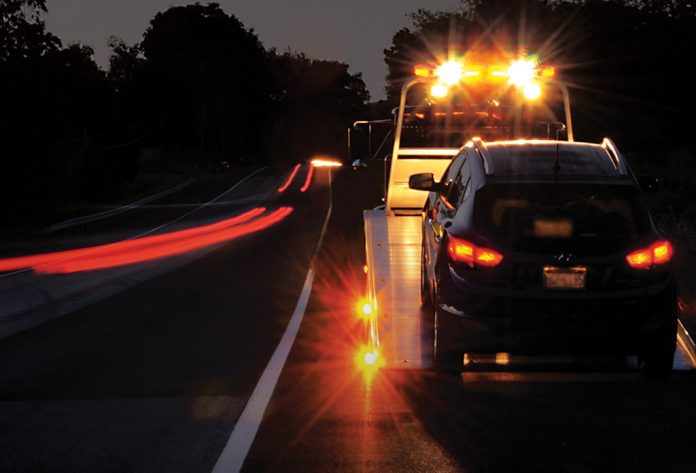
By Tom Bray
Before we get into the discussion of the lighting requirements that are specific to tow trucks, let’s look at the general lighting requirements in the federal regulations. These requirements are found in two places:
- The National Highway Traffic Safety Administration’s (NHTSA) Federal Motor Vehicle Safety Standard (FMVSS) 108, also known as FMVSS 108 or Section 571.108 (since it is located in Part 571), and
- The Federal Motor Carrier Safety Administration (FMCSA) regulations at Section 393.11.
The NHTSA regulations apply to new vehicles and the FMCSA regulations apply to vehicles that are presently in service. The two are tied together more closely than one might think. The FMCSA regulations (and most states) require that the vehicle, for the entire time it is in service, continues to meet the FMVSS requirements that were in place when the vehicle was built.
The basic light package that is required includes:
- Headlights
- Taillights
- Brake lights
- Front and rear turn signals
- Front and rear side markers (lights that are visible from the side to indicate the length of the vehicle)
- Front and rear clearance lights (lights that indicate the overall width of the vehicle)
- Backup lights (activated when the vehicle is in reverse)

The vehicle must also have reflectors at the “corners,” visible from the side and rear.
Lights are allowed to serve multiple purposes, such as the vehicle’s “front parking lights” serving as both the front side marker light and the front clearance light, and having a reflective lens cover so it can serve as the front side reflector as well.
Extra lights may be required
If the vehicle is over certain dimensions, then additional lights will be required. If the vehicle is over 30 feet long, it must have an intermediate side marker light (and reflector) mounted at roughly the middle of the vehicle’s length. If the vehicle is over 80 inches wide, it must have a set of “identification markers” on the front and rear. The “ID markers” are the set of three lights mounted on top of the vehicle. They are there to identify the vehicle to other traffic as a wider-than-normal vehicle.
Light color is closely regulated
The regulations specify what color and what candlepower all of these required lights must be. In general, headlights and backup lights need to be white, rear-facing lights and the side marker lights at the rear corner of the vehicle need to be red, and all other markers and clearance lights need to be yellow. The only required lights on the vehicle that can be either red or yellow are the rear turn signals, provided they are not combined with a brake light. If the rear signal is combined with a brake light, the light must be red and the signal light must be the one that is active if the brakes and signals are active at the same time.
Be careful when making modifications
Most vehicle and body manufacturers know these rules quite well and build their vehicles to comply. Doing aftermarket modifications to the vehicle or the body is what gets vehicle owners or operators in trouble when it comes to the required lights.
Tow truck specific requirements
At the federal level, mounting “lights other than those required” and/or “auxiliary lights” are allowed, as long as they do not reduce the effectiveness of the required lights or create confusion, and as long as the type or color of light is not prohibited. Additional lights must also comply with the state’s rules related to color and placement. For example, some states restrict the use of certain color auxiliary lights to specific vehicles — such as reserving blue for law enforcement or white strobes for school buses. Also, the driver must comply with any use restrictions the state may have in place on the use of additional or auxiliary lights.
States also place additional lighting requirements on certain vehicles, such as tow trucks. To operate as a tow truck in many states, the vehicle must be equipped with oscillating, rotating, or strobe lights of a specific color. Several states require two colors, one to be used when stopped on the side of the road (such as when hooking up at an accident scene) and another for use when actually towing another vehicle.
Most states also require that, if the lights on the rear of the tow truck are not readily visible to traffic following the tow truck, basic lights be placed at the rear of the vehicle being towed. There is a liability issue here as well. If the taillights, brake lights, and rear turn signals of the tow truck are not visible to traffic following the tow truck and it leads to an accident, the operator and company could both be held liable.
How do you find out about the tow-truck specific lighting rules? If you are on the city or county “rotation,” or have a “contract” with the city or county to do towing, the tow-truck lighting requirements may be included in the paperwork. If you cannot locate the information and you are not sure what the requirements are, you may contact your state or local towing association, or a local, county, or state police officer with thorough knowledge of the state vehicle regulations.
Thomas Bray is Sr. Editor – Transportation Management for J.J. Keller & Associates, Inc. Contact him at transporteditors@jjkeller.com. Also be sure to check out J. J. Keller’s website at www.jjkeller.com.
Copyright 2014 J. J. Keller & Associates, Inc.®
PO Box 368
3003 Breezewood LaneNeenah WI 54957-0368






